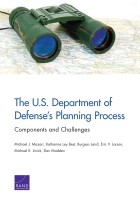| 来源类型 | Research Reports
|
| 规范类型 | 报告
|
| DOI | https://doi.org/10.7249/RR2173.2
|
| ISBN | 9780833099907
|
| 来源ID | RR-2173/2-A
|
| The U.S. Department of Defense's Planning Process: Components and Challenges |
| Michael J. Mazarr; Katharina Ley Best; Burgess Laird; Eric V. Larson; Michael E. Linick; Dan Madden
|
| 发表日期 | 2019
|
| 出版年 | 2019
|
| 页码 | 68
|
| 语种 | 英语
|
| 结论 |
The defense planning process uses scenarios for a range of purposes, complicating selection criteria- Defense strategic guidance uses scenarios to create a list of generic capabilities. However, any given set of capabilities required in one scenario may be vastly different in scale and composition than the capabilities used in another scenario.
The primary challenges in using scenarios reside in their practical implementation, not in the overall structure of the process- The current process pays significant attention to the choice of assumptions, but it lacks time and resources to adequately explore the implications of these assumptions.
- There are any number of potential wars the United States could fight, and the compound probability of some of them occurring simultaneously is rarely seriously examined. Therefore, choosing to size or prepare for any combination of scenarios involves guesswork rather than meaningful strategic judgment.
- The quality and utility of the process are functions of strong senior leadership engagement and commitment.
The process of narrowing down to a handful of force planning scenarios can be subjective and arbitrary- Senior defense leaders are understandably preoccupied with the challenges immediately in front of them and generally less interested in thinking about long-range or out-of-the-box scenarios.
The assessment of scenarios has become so exhaustive and inflexible that it constrains the responsiveness of the overall process- The employment of scenarios in support of defense planning is not in need of a radical overhaul, but important improvements need to be made to enhance its credibility, agility, and robustness.
|
| 摘要 |
- It is easy to become focused on the details of the process, but the ultimate metric for success is whether the system is producing compelling stories that convey the full range of current and potential threats and gaps in U.S. capabilities to deal with them, and whether the scenarios provide useful and timely analysis to inform the defense planning process.
- DoD could benefit from placing greater emphasis on nonstandard scenarios rather than focusing energy on long-term deliberate planning for one or two expected ones.
- Scenario-building and assessment must include detailed consideration of assumptions, including sensitivity analysis.
- Slow responsiveness and lack of flexibility are among the greatest impediments to a more-effective and responsive defense planning process.
- The process should explore a broader set of low-fidelity scenarios to hedge against surprise.
- The process should also explore current scenarios with a focus on innovation.
- The current process is not as responsive as it could be because it is not designed to anticipate scenarios that could emerge at some future point; it should prioritize beyond the force-sizing construct.
- Acknowledging assumptions is not enough — they must be assessed. A revised process could take the assumption phase more seriously. It could subject assumptions to rigorous analysis and debate and force the system to take seriously the implications of its conventional wisdom. It also could inform this discussion with a more-detailed estimate of the relationship between specific assumptions and outcomes.
|
| 主题 | Military Force Planning
; Military Strategy
; United States Department of Defense
; Wargaming
|
| URL | https://www.rand.org/pubs/research_reports/RR2173z2.html
|
| 来源智库 | RAND Corporation (United States)
|
| 引用统计 |
|
| 资源类型 | 智库出版物
|
| 条目标识符 | http://119.78.100.153/handle/2XGU8XDN/108971
|
推荐引用方式
GB/T 7714 |
Michael J. Mazarr,Katharina Ley Best,Burgess Laird,et al. The U.S. Department of Defense's Planning Process: Components and Challenges. 2019.
|
|
文件名:
|
x1549287460758.jpg
|
|
格式:
|
JPEG
|

|
文件名:
|
RAND_RR2173z2.pdf
|
|
格式:
|
Adobe PDF
|
除非特别说明,本系统中所有内容都受版权保护,并保留所有权利。